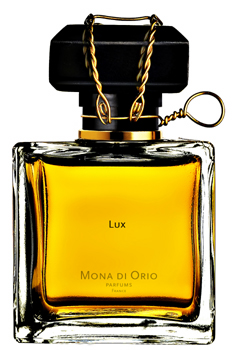Lux by Mona di Orio {Perfume Review & Musings}

Each fragrance is dedicated to a personality that has marked the life of Mona di Orio. Nuit Noire is an oriental dedicated to Serge Lutens; Carnation is a sensual fragrance dedicated to writer Colette, an author famous for her evocative olfactory, and more generally, sensualist descriptions of the natural world; Lux finally is dedicated to Mona di Orio's own master in the art of perfumery, the author of Femme, Diorella, Eau Sauvage, who is none other than Edmond Roudnitska........
Lux is a dark green, camphoraceous, and woody perfume with some sweetness to it as well as a powdery character. It has a rich citrus-y accord that cuts across the perfume. This citrus-y accord is the only literal olfactory reference one can find to the name of the perfume meaning "light" in Latin.
One could characterize Lux as a fragrance for the connoisseur if only because of the intensity of some of its notes. It makes the fragrance smell almost repulsive at times. It feels like a strange version of Shalimar with its sweetness, powderiness, and leather that would have crossed over to the other side of the mirror. In that other world, Shalimar has lost its classicism and has become distorted by the hands and vision of El Greco. It is more intense, rougher, stranger, and perhaps even ugly by classical standards. One could also see it as a fiercer version of Jicky.

Despite its name Lux is by no means a uniformly luminous perfume. The light that shines in it is the biblical light that juxtaposes itself against the darkness of chaos. A more apt term to describe this effect would be that of "chiaroscuro" in Italian or "clair obscur" in French, as the structure of the perfume seems analogous to that of a painting playing with the contrasts of a golden light and dark shadow. One thinks of paintings by Il Caravaggio, Rembrandt, and Georges de la Tour.
When first applied the perfume immediately evokes a deep breath-of-the-dragon effect. The perception oscillates between thinking more of camphor, mothballs, old dusty papers or thinking more of the smell of sewage. The images that the perfume evokes are old mummies, antique tombs, catacombs, the interior chambers of an Egyptian pyramid, and an ancient dusty library in which ruined coffers were filled with antique parchments and manuscripts and whose floor were half-covered with part sand from the desert and part dust from the passing of time. In short, it is a perfume which offers a certain a macabre charm.
It is not a subtle perfume. It has however depth and psychological complexity if not structural complexity. It makes one feel from the beginning that the brush strokes applied here are of a powerful and energetic nature. From the start, the complex of Sicilian lemon, litsea cubeba, and petitgrain bigarade together with the vanillic powder and labdanum are the main notes and all three themes come across as pungent. Then the perfume loses some of its physical energy and becomes more meditative. This is when the camphoraceous accord sets in, as well as the almost fetid aspect of the perfume. The fragrance pushes the limits of olfactory sensitivity, further than does Fleur de Cassie by Dominique Ropion for Frederic Malle. After several applications we are more struck by the authenticity of the aromas as well as their rare character than by the asperities of the scent. It is a beautiful perfume whose beauty seems almost more internal than external. Lux has a soul and it could touch you.

It is like a diamond in the rough and, in this sense too, there is a light in it waiting to be released. Now, we cannot wait to try the other two Mona di Orios.
Top notes include Sicilian lemon, litsea cubeba, petitgrain bigarade. Heart notes include vetiver, Marrocan cedarwood and sandalwood Mysore. Base notes include musc, amber, vanilla bourbon and labdanum.
It is sold exclusively at Aedes.










What an interesting coincidence! I just reviewed Nuit Noire today. Wow, I had no idea it was dedicated to Serge Lutens. No wonder it's my favorite of the line! Thanks for a detailed description of Lux. Sadly, it was my least favorite of the trio.
It's definitely not easy to like Lux. But I think it has something. It touches me at least.
I'm on my way to reading you. I want very much to sniff her other creations, especially Nuit Noire, in part because of the reference to Serge Lutens, but also because I'm going to review two of Andy Tauer's perfumes. I see some interesting affinities.
Huh. I went back to check my notes on this. Weirdly, I found this one to be sort of citrusy and green and pretty, but not animalic. And I DID like it (maybe my nose is deficient?) However, I found the Nuit Noire to be intensely animalic, and the Carnation reminded me of Lipstick Rose with an unhealthy addition of mildew... I have to go read Ina's review now.
I found it immediately interesting and NOT pretty:D
Your nose is fine! So many things can influence the perception of a perfume. Who knows whose nose knows?
It's a beautiful fragrance.